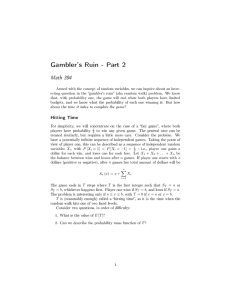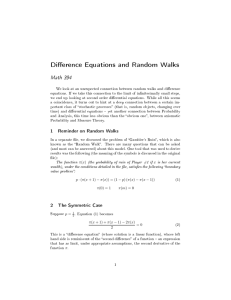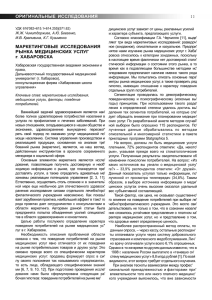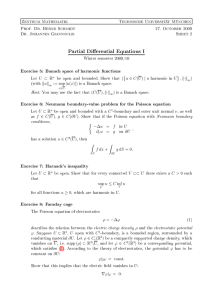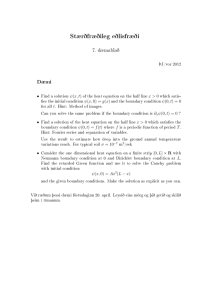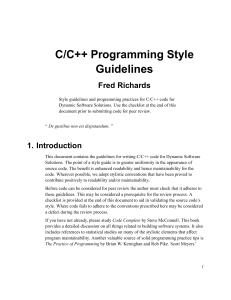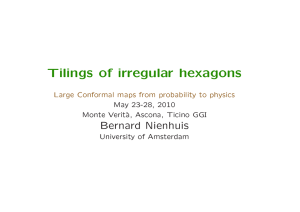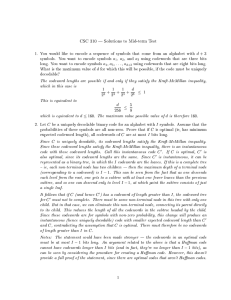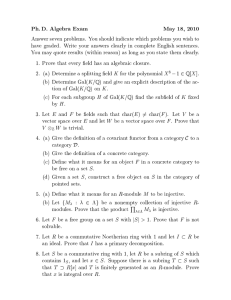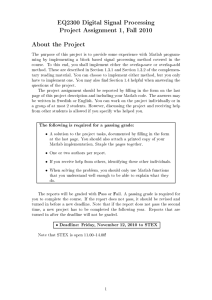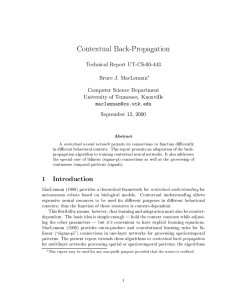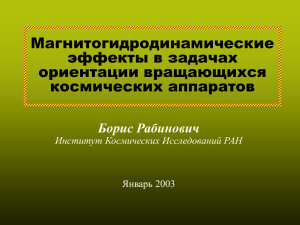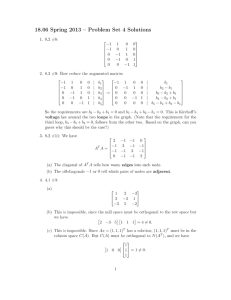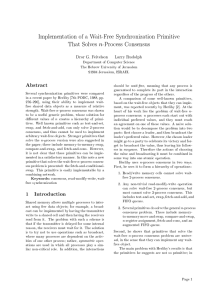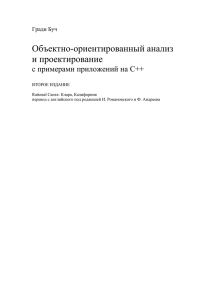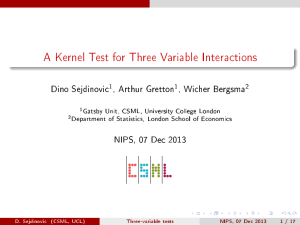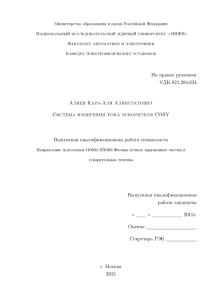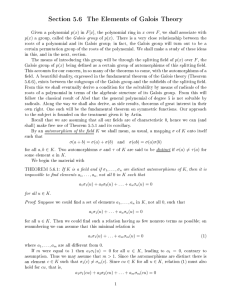бсыжр п с л сж ь п х щв × гр ь ппсвь ж р ж п ь р ь
advertisement

Journal of Theoretial Physis 217 (2013) Founded and Edited by M. Apostol ISSN 1453-4428 On the allosteri and related kinetis M. Apostol Department of Theoretial Physis, Institute of Atomi Physis, Magurele-Buharest MG-6, POBox MG-35, Romania email: apomatheory.nipne.ro Abstrat The Mihaelis-Menten law and the Monod-Wyman-Changeux model for allosteri kinetis are derived by means of the general relaxation (deay) laws. Mihaelis-Menten law. In a lassi paper[1℄ it was shown that the reation E + S ⇋kk12 ES →k3 E + P , (1) where E is an enzyme, S is a "substrate", P is a produt of reation and k1,2,3 are reation onstants, obeys approximately the Mihaelis-Menten law dp s = const , dt const + s (2) where s, p are the onentrations of the substrate S and, respetively, produt P and t is the time. The derivation goes as follows: de/dt = −k1 e · s + k2 (es) + k3 (es) , ds/dt = −k1 e · s + k2 (es) , (3) d(es)/dt = k1 e · s − k2 (es) − k3 (es) , dp/dt = k3 (es) , where e and (es) are the onentration of the enzyme E and, respetively, the omplex enzymesubstrate ES ; from the rst and the third equations (3) we get e + (es) = const, whih expresses the onservation of the enzyme onentration; assuming the equilibrium k1 e · s = k2 (es) (ds/dt = 0) we get e + (k1 /k2 )e · s = const from the onservation law, or e = const/(const + s) and dp/dt = const · s/(const + s) from the last equation (3); this is the Mihaelis-Menten law. It is easy to see that this derivation and the kineti equations (3) have several drawbaks; the kineti equations imply the law of mass ation, based usualy on (low-dilution, high-mobility) diusion, whih is rather unrealisti in enzymati reations; the nal rate k3 must be muh smaller that the rate k2 , in order to have equilibrium in the rst step of the reation; this implies a low onentration of enzyme; it would be more reasonably to write the equilibrium as k1 e · s = k2 (es) + k3 (es), whih leads to the same Mihaelis-Menten law,[2℄ or to admit the reversibility in the last step of the kineti equations, i.e. to write the reation as E + S ⇋kk12 ES ⇋kk34 E + P . (4) In any ase, the underlying mehanism of the Mihaelis-Menten law is questionable, though the law with its saturation-like harater seems to be valid in pratie; some versions of the law imply often an inexion point (a sigmoid urve), whih is validated by pratie. Kineti laws. The problem onsists in estimating the reation produt as a funtion of the onentration of one reatants, say the substrate, at equilibrium for a general reation written as (E, S) ⇋ (E, P ). We denote by f the onentration of the produt and by x the onentation of the substrate. Inreasing x by dx will inrease the produt by df ; the simplest law for this proess is df = Bλdx, where B and λ are onstants. The produt disappears also, with the simplest (deaying, relaxing) law df=-λfdx. Combining the two ontributions we get the kineti equation df + λf = Bλ ; dx (5) f = B + Ce−λx , (6) the solution is where C is a onstant; for a vanishing produt at the initial x = 0, we get B + C = 0 and f = B(1 − e−λx ) ; (7) the produt is generated initially with the rate Bλ, as obtained either from equation (7) for small x (f ≃ Bλx) or from equation (5) by negleting the small term λf ; and for larger x it saturates at f = B (equation (7)), i.e. its slope is vanishing in equation (5) whih gives indeed f = B . The proesses desribed above an be ompliated by inluding a ooperative aspet; instead of df = Bλdx we may have df = 2Bλxdx and instead of df = −λf dx we may have df = −2λxf dx, leading to the equation df + 2λxf = 2Bλx ; (8) dx whose solution is 2 f = B + Ce−λx , or 2 f = B(1 − e−λx ) (9) (10) for f (x = 0) = 0. This solution has an inexion point. Similarly, we an onsider the equation df + λαxα−1 f = Bλαxα−1 dx (11) with α > 1 and get a generalized solution α f = B(1 − e−λx ) . Monod-Wyman-Changeux model.[3, 4℄ as f =B (12) First we note that equation (7) an also be written eλx − 1 λx x ≃ B = const , eλx 1 + λx const + x (13) whih is the Mihaelis-Menten law. Similarly, using equation (10) or equation (12), we get f ≃ const · x2 /(const + x2 ) or f ≃ const · xα /(const + xα ), whih is a generalization of the MihaelisMenten law. The relaxation equation (6) suggests a deaying law, whih, written for two populations (two hannels, allosteri ativity), reads (14) N1 = N01 e−λ1 x , N2 = N02 e−λ2 x = N01 e−λ2 x /L , where L = N01 /N02 ; it is worth noting that eλ 1 x eλ1 x +Leλ2 x Leλ2 x eλ1 x +Leλ2 x = N01 /N1 N01 /N1 +N01 /N2 = N01 /N2 N01 /N1 +N01 /N2 = N2 N1 +N2 , = N1 N1 +N2 , (15) so that eλ1 x and Leλ2 x an be used as statistial weigths. We may write also eλ1 x (1 + λ1 x/n)n ≃ eλ1 x + Leλ2 x (1 + λ1 x/n)n + L(1 + λ2 x/n)n (16) or, redening λ1 x/n → x and denoting λ2 = cλ1 , eλ1 x (1 + λ1 x/n)n (1 + x)n ≃ = ; eλ1 x + Leλ2 x (1 + λ1 x/n)n + L(1 + λ2 x/n)n (1 + x)n + L(1 + cx)n (17) this is the Monod-Wyman-Changeux model. We an see that (1 + x)n has the aspet of a sum of multiple states with weigths 1 and x, so we an dene the mean of the x-state Y = cx + x)n + 1+cx L(1 + cx)n x(1 + x)n−1 + Lcx(1 + cx)n−1 = , (1 + x)n + L(1 + cx)n (1 + x)n + L(1 + cx)n x (1 1+x (18) whih is the so-alled saturation funtion (it exhibits saturation and inexions). By equation (12) we may erplae x by xα in equation (18), whih is a generalization of the saturation law. Referenes [1℄ L. Menten and M. I. Mihaelis, "Die Kinetik der InvertinWirkung", Biohem. Z. (1913). 49 333-369 [2℄ G. E. Briggs and J. B. S. Haldane, "A note on the kinetis of enzyme ation", Biohem. J. 19 338-339 (1925). [3℄ J. Monod, J. P. Changeux and F. Jaob, "Allosteri proteins and ellular ontrol systems", J. Mol. Biol. 6 306-329 (1963). [4℄ J. Monod, J. Wyman and J. P. Changeux, "On the nature of allosteri transitions: a plausible model", J. Mol. Biol. 12 88-118 (1965). J. Theor. Phys. 2013, apomatheor1.theory.nipne.ro
